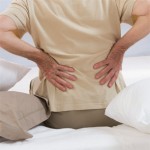As physician and writer Abraham Verghese said, ‘Modern medicine is in danger of losing a powerful, old-fashioned tool: human touch.’
Conclusion
Myofascial pain commonly is overlooked in patients who present with multiple comorbidities or complex disease states. A physical therapist is skilled in evaluating and treating soft-tissue dysfunction with the use of a variety of techniques, and the most common are mentioned above. Hopefully, this article has given you a better understanding of the principles, physiology, and evidence surrounding the techniques of functional dry needling, specific soft-tissue mobilization, myofascial release, muscle energy techniques, and joint mobilization/manipulation.
Alicia Lovato is a physical therapist at Azura at Home and Azura of Lakewood Rehabilitation Suites in Wheat Ridge, Colo. She studied physical therapy at Regis University and is a member of the ARHP Practice Committee.
References
- Seem M. A new American acupuncture: Acupuncture osteopathy. Boulder, CO: Blue Poppy Press; 2007.
- Dommerholt J, Huijbregts P. Myofascial trigger points: Pathophysiology and evidence-informed diagnosis and management. Boston, MA: Jones & Bartlett; 2011.
- Leadbetter W. Cell-matrix response in tendon injury. Clin Sports Med. 1992;11:533-578.
- Hunter G. Specific soft tissue mobilization in the treatment of soft tissue lesions. Physiotherapy. 1994;80:15-21.
- Hunter G. Specific soft tissue mobilization in the management of soft tissue dysfunction. Physiotherapy. 1998;3:2-11.
- Bennet R. Rheumatic Disease Clinics of North America. Philadelphia, PA: Saunders; 2002.
- Nijs J, Van Houdenhove B. From acute musculoskeletal pain to chronic widespread pain and fibromyalgia: Application of pain neurophysiology in manual therapy practice. Man Ther. 2009;14:3-12.
- Castro-Sanchez A, Mataran-Penarrocha G, Arroyo-Morales M. Effects of myofascial release techniques on pain, physical function, and postural stability in patients with fibromyalgia: A randomized controlled trial. Clin Rehabil. 2011;25:800-813.
- Karageanes S. Principles of Manual Sports Medicine. New York: Lippincott Williams & Wilkins; 2004.
- Day J, Nitz A. The effect of muscle energy techniques on disability and pain scores in individuals with low back pain. J Sport Rehabil. 2012;21:194-198.
- Simmons SL. Osteopathic manipulative medicine: Review for the boards. 1st ed. Ft. Worth, TX: Stephan L. Simmons, DO; 2011.
- Jones LH. Spontaneous release by positioning. The DO. 1964;4:109-116.
- Bronfort G, Haas M, Evans R. Evidence-informed management of chronic low back pain with spinal manipulation and mobilization. Spine J. 2008;8:213-225.


